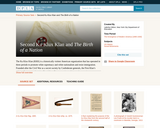
Explain the difference between stereotypes, prejudice, discrimination, and racism
Identify different types of discrimination
View racial tension through a sociological lens
- Material Type:
- Module
- Date Added:
- 09/20/2018

Explain the difference between stereotypes, prejudice, discrimination, and racism
Identify different types of discrimination
View racial tension through a sociological lens

Online companion to "Matters of Race" PBS program, which explores what makes a race, who decides what race means, the issues faced by people of mixed race, and the future of race in America. Includes essays, an area for sharing personal comments, a teacher's guide, and interactive statistics.

This collection uses primary sources to explore the postwar growth of the American suburbs. Digital Public Library of America Primary Source Sets are designed to help students develop their critical thinking skills and draw diverse material from libraries, archives, and museums across the United States. Each set includes an overview, ten to fifteen primary sources, links to related resources, and a teaching guide. These sets were created and reviewed by the teachers on the DPLA's Education Advisory Committee.

In this interactive lesson, students use primary sources, including posters, documents, artifacts from The International Museum of World War II, and videos, to examine how and why propaganda was used by combatant nations with such powerful effect during World War II.

Psychology is designed to meet scope and sequence requirements for the single-semester introduction to psychology course. The book offers a comprehensive treatment of core concepts, grounded in both classic studies and current and emerging research. The text also includes coverage of the DSM-5 in examinations of psychological disorders. Psychology incorporates discussions that reflect the diversity within the discipline, as well as the diversity of cultures and communities across the globe.Senior Contributing AuthorsRose M. Spielman, Formerly of Quinnipiac UniversityContributing AuthorsKathryn Dumper, Bainbridge State CollegeWilliam Jenkins, Mercer UniversityArlene Lacombe, Saint Joseph's UniversityMarilyn Lovett, Livingstone CollegeMarion Perlmutter, University of Michigan



By the end of this section, you will be able to:
Define and distinguish among prejudice, stereotypes, and discrimination
Provide examples of prejudice, stereotypes, and discrimination
Explain why prejudice and discrimination exist

This 13-lesson unit, adapted from our Reconstruction Era book, is designed to fit within approximately three weeks. In this unit, students investigate the challenges of creating a just democracy in a time of deep division.
Unit Essential Question: What can we learn from the history of Reconstruction as we work to strengthen democracy today?

Students will utilize research skills to gain awareness of contemporary Unfreedoms: Racism, Illiteracy, Genocide, Hunger, Tyranny and Slavery. Students will demonstrate their ability to write a short summary, propose solutions to global human rights issue

The Ku Klux Klan (KKK) is a historically violent American organization that has operated in three periods to promote white supremacy and white nationalism and resist immigration. Founded after the Civil War as a secret society by Confederate generals, the First Klan‰Ûªs primary focus was subverting Republican Reconstruction policies and preventing emancipated African Americans from receiving the benefits of citizenship. Despite its success disrupting black political participation through threats and actual violence, federal government efforts to suppress the Klan in 1870-1871 forced in a major decline in its activities.

Children look to their families with love and trust to guide their understanding about their place in this great big world. Here are some easy-to-use resources to help guide conversations with your child about racism and coming together through one small word-we-in support of racial justice for all.

This segment from American Experience: "Simple Justice" documents Dr. Kenneth Clark's "doll test," which became important social science evidence in Brown case. [5:44]

Students will gain an understanding of how Asian Americans and Pacific Islanders (AAPI) have faced physical and verbal attacks due to unjustly being blamed for the COVID-19 pandemic. They will also learn how the AAPI community has taken action against anti-Asian hate. The lesson is centered around an excerpt from the One Nation AAPIs Rising to Fight Dual pandemics: COVID-19 and Racism. Support materials are provided.

From Debbie Levy: "Today, Jo Ann will be the first to remind you that she is just one of twelve black students who went through the agonizing experience of desegregating Clinton High School. She'll make sure you know that because of her parents' decision to leave, she spent only one semester there. The heroes, she'll say, are Bobby Cain and Gail Ann Epps - the ones who hung in there long enough to graduate despite the danger and discomfort of showing up, day after day, to a place where they knew they were not wanted. I say they are all heroes."

From Debbie Levy:"Today, Jo Ann will be the first to remind you that she is just one of twelve black students who went through the agonizing experience of desegregating Clinton High School. She'll make sure you know that because of her parents' decision to leave, she spent only one semester there. The heroes, she'll say, are Bobby Cain and Gail Ann Epps - the ones who hung in there long enough to graduate despite the danger and discomfort of showing up, day after day, to a place where they knew they were not wanted. I say they are all heroes."

An article celebrating the 50th anniversary of the famous Brown v. Board Supreme Court decision. Features background information, a timeline of integration of schools, interviews, and links to many other activities and resources covering the topics of racism, bullying, and tolerance.

This video [5:08] from American Masters: Harper Lee: Hey, Boo describes what life was like for those who challenged the system of segregation in the South in the late 1950s and early 1960s. Highlighting observations from cultural and literary icons as well as average American citizens, this video features important commentary that addresses the issues presented in To Kill a Mockingbird and how the public reacted to the novel when it was first published in 1960. Teaching materials are included.

This is a complete study guide for the novel To Kill a Mockingbird by Harper Lee including chapter-by-chapter guided reading questions (aligned to specific Common Core Standards), discussion questions, various writing prompts, and research topics.

An interview illustrating some of the ways community functioned in the lives of African Americans. It explores how external pressures of racism brought African Americans together to form fraternal organizations and entire towns.